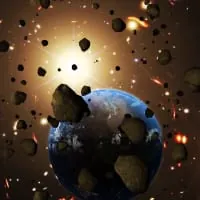
Did Earth Once Sport a Ring Like Saturn? Shocking Evidence Suggests It Might Have!
2024-09-26
Did Earth Once Sport a Ring Like Saturn? Shocking Evidence Suggests It Might Have!
The rings of Saturn are iconic and mesmerizing, captivating astronomers and stargazers alike. But what if I told you that Earth might have had its own version of these celestial adornments? A recent breakthrough study published in Earth and Planetary Science Letters proposes a tantalizing theory: around 466 million years ago, Earth might have been encircled by a ring, akin to Saturn's.
Unveiling the Evidence: A Chaotic Era
Approximately 466 million years ago, our planet underwent a dramatic upheaval characterized by a surge of meteorite impacts. This period left its mark with a notable number of impact craters formed in a geologically brief span. In conjunction with these craters, deposits of limestone discovered across vast regions—Europe, Russia, and China—contain unusual traces of meteorite debris. Intriguingly, this debris exhibits signs indicating that it was exposed to space radiation for far less time compared to meteorite remnants we find today.
Adding to the chaos, numerous tsunamis struck the Earth, leaving behind a jumbled tapestry of sedimentary rocks. Could these phenomenon be interconnected? Researchers believe they might be.
Mapping the Crater Conundrum
With 21 meteorite impact craters identified from this tumultuous period, scientists sought to examine their distribution across the globe. Through analyses of historical tectonic plate movements, they discovered that all craters were located on continents that resided near the equator at that time, with none found closer to the poles. This is peculiar, as only about 30% of Earth's land surface suitable for preserving craters was near the equator then, leading to a tantalizing question: Why were all impacts concentrated towards the equator?
The researchers propose that a large asteroid fragmented during a close proximity encounter with Earth, showering the planet with debris over several tens of millions of years. This might explain the peculiar craters, sediment deposits, and tsunami activity observed during this epoch.
How Rings Are Born
While Saturn's rings are the most celebrated, they are not alone in the universe. Jupiter, Neptune, and Uranus also boast rings, and scientists even speculate that Mars’ moons, Phobos and Deimos, could be remnants of an ancient ring system.
The mechanics of how planetary rings form is well-understood: when a small celestial body (like an asteroid) ventures too close to a massive body (like Earth), gravitational forces stretch it. If it crosses the Roche limit, this small body disintegrates into numerous pieces, collectively forming a debris ring around the equatorial plane of the larger body.
So, if an asteroid indeed broke apart during its close encounter with Earth 466 million years ago, it could account for the peculiar clustering of impact craters and geological anomalies we observe.
An Unexpected Climate Catalyst?
At that time, continental positions differed vastly from today. Parts of North America, Europe, and Australia were located near the equator, while regions such as Africa and South America were situated at higher southern latitudes. Through this lens, the hypothesized ring would have shaded certain areas of Earth, potentially leading to global cooling due to decreased sunlight.
Fascinatingly, geological evidence suggests that Earth began to cool dramatically around 465 million years ago, culminating in the Hirnantian Ice Age—an extreme cold snap that was the most frigid era in the last half-billion years.
Could a celestial ring have had a hand in this significant climate shift? Researchers are now setting their sights on mathematical models to unravel how asteroids might break up and how their remnants could evolve over time. This could provide invaluable insights into climate scenarios that examine the cooling effects such a ring could impose.
The Big Reveal: Impacts Beyond Our Imagination!
As scientists continue to probe the history of our planet, the prospect of Earth having once sported a stunning ring like Saturn opens up a wealth of questions and curiosities. This captivating research not only sheds light on our planet's tumultuous past but also invites us to ponder the hidden mysteries of our cosmic neighborhood. Stay tuned as we dive deeper into the incredible saga of Earth’s ancient environment!









 Brasil (PT)
Brasil (PT)
 Canada (EN)
Canada (EN)
 Chile (ES)
Chile (ES)
 España (ES)
España (ES)
 France (FR)
France (FR)
 Hong Kong (EN)
Hong Kong (EN)
 Italia (IT)
Italia (IT)
 日本 (JA)
日本 (JA)
 Magyarország (HU)
Magyarország (HU)
 Norge (NO)
Norge (NO)
 Polska (PL)
Polska (PL)
 Schweiz (DE)
Schweiz (DE)
 Singapore (EN)
Singapore (EN)
 Sverige (SV)
Sverige (SV)
 Suomi (FI)
Suomi (FI)
 Türkiye (TR)
Türkiye (TR)